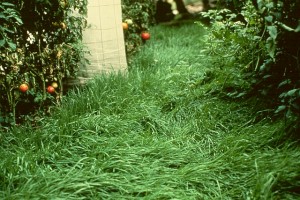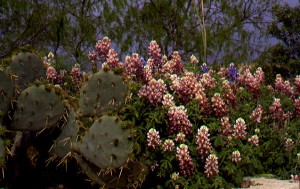San Antonio Express News
GARDENING, Etc.
Sunday, October 23, 2005
By Dr. Jerry Parsons
 Do you like having a green lawn throughout the year? Is it appropriate to over seed your lawn for the winter? These are just a few questions that you need to ask yourself before you over seed and renovate your turf. Warm season grasses such as Bermuda and zoysias go dormant during the winter months and can be over seeded with a cool season grass variety to maintain green color and adequate quality. This DOES NOT include St. Augustine grass which stays green-and-growing all South Texas “winter” long-unless we have a hard freeze below 20 degrees F.
Do you like having a green lawn throughout the year? Is it appropriate to over seed your lawn for the winter? These are just a few questions that you need to ask yourself before you over seed and renovate your turf. Warm season grasses such as Bermuda and zoysias go dormant during the winter months and can be over seeded with a cool season grass variety to maintain green color and adequate quality. This DOES NOT include St. Augustine grass which stays green-and-growing all South Texas “winter” long-unless we have a hard freeze below 20 degrees F.
To gather some insight on this topic, I used some of the information from Dr. Jim McAfee and Roger Havlak, Texas Cooperative Extension Turfgrass Specialists. The following is what they have to say about over seeding and weed control.
The best time to over seed the home lawn is mid-to-late October and early November, but more accurately after the first frost. Annual ryegrass is the fastest germinating variety and probably the cheapest. It looks very similar to perennial ryegrass with a dark green color and shiny leaves. Annual ryegrass grows quickly and requires frequent mowing (around 2 to 2.5 inch height) especially during late fall and early spring. Their water use rates are moderate and fertility requirements are low maybe one to two pounds of nitrogen over the winter months. For a dense stand of rye grass, over seed at a rate of about 10 12 pounds of seed per thousand (33 feet by 33 feet) square  feet. And keep the lawn irrigated for several weeks to ensure germination.
feet. And keep the lawn irrigated for several weeks to ensure germination.
There is a new annual rye grass from Texas A&M named “Pantera.” This annual type look and growmore like the perennial types. The annual types will die out faster in the spring, and therefore, don’t create as much a problem for the turfgrass growing in the lawn. For information about how to over seed, and should you over seed as well as overseeding bermuda with bluebonnets, see the fifth column in the October listing at: http://www.plantanswers.com/garden_columns.htm
with the title: Over seeding, Interseeding, Winter Weed Control and Bluebonnets.
Over seeding this fall might lead to warm-season turf with some very serious problems next year, because of the summer we have had this year. A healthy warm season turf being over seeded is severely weakened as it is from the competition of the aggressive cool-season turfgrass being planted into it. Over seeded warm-season turfs are weak and sickly looking in the spring when they transition back to the dominant turf – imagine what you will likely have if you are over seeding an already thin turf this fall. Next year will be the easiest transition year you have ever had – know why? There won’t be a transition for a lot of us, because there won’t be a warm season grass remaining! Instead of over seeding, you should raise the turf cutting height and make sure to apply a Winterizer fertilizer. See: http://www.plantanswers.com/garden_column/101301.htm
 Allow it to fully prepare for the upcoming winter by naturally hardening off through the day/night heating/cooling patterns of this time of year. You should also consider replacing large areas of damaged turf with Floratam St. Augustine (http://www.plantanswers.com/grass.htm ) until late November. Turfgrass producers such as Milbergers are selling a 50-yard pallet of Floratam for $130. A 50-yard pallet covers 450 square feet with 150 pieces of sod which are 24 inches by 16 inches in size. A half-pallet or 25 yard pallet (225 square feet) of Floratam is available for $87. Milbergers will also take orders for smaller amounts to help people with less damage. But remember, ONLY Floratam should be used to replace the damaged St. Augustine caused by this summer’s problems. See: http://www.plantanswers.com/brown_spots.htm
Allow it to fully prepare for the upcoming winter by naturally hardening off through the day/night heating/cooling patterns of this time of year. You should also consider replacing large areas of damaged turf with Floratam St. Augustine (http://www.plantanswers.com/grass.htm ) until late November. Turfgrass producers such as Milbergers are selling a 50-yard pallet of Floratam for $130. A 50-yard pallet covers 450 square feet with 150 pieces of sod which are 24 inches by 16 inches in size. A half-pallet or 25 yard pallet (225 square feet) of Floratam is available for $87. Milbergers will also take orders for smaller amounts to help people with less damage. But remember, ONLY Floratam should be used to replace the damaged St. Augustine caused by this summer’s problems. See: http://www.plantanswers.com/brown_spots.htm
Expect a lot of winter weeds in an area with a thin turf cover. The thin turf that has received some rainfall during the last couple of weeks is sure to be invaded by a bumper crop of winter weeds. If you are not over seeding, apply a fall pre-emergence herbicide AS SOON AS POSSIBLE. What is being used: these are the most common choices – prodiamine, pendimethalin, Balan plus oryzalin (Amaze) and dithiopyro (Dimension). All of these are excellent PRE materials, each with their own strengths and weaknesses. Be very careful with late season cultivation events on warm season grasses after the summer we have had. The weaker your warm-season turf is, the more likely the damage this winter.
The biggest problem encountered by homeowners, and especially pet owners in this area, is thinning turf in shady, high-traffic-by-pets areas usually planted with St. Augustine grass because of its shade tolerance. Throughout this column, it has been stated over and over NOT to over seed St. Augustine- but what about interseeding of Pantera rye with St. Augustine. The term over seeding means to create a thick turf of rye on top of an established bermuda or zoysia turf. What I am proposing is that you folks with a sparse stand of St. Augustine in shady, pet-trampled areas, cut the over seeding rate by one-half (use 5 – 6 poundsper 1,000) in an interseeding program. The benefits of interseeding are thicker turf and more organic matter added to the soil from the expanding rye root system. Cereal rye (Elbon) has been used for years in home gardens as the best nematode control and source of large quantities of “green manure” furnished by the decomposing rootsystem of the rye in the spring. See:
http://aggie-horticulture.tamu.edu/PLANTanswers/earthkind Why can’t we do the same for our lawns with Pantera rye. Pantera rye is being sold only in 50 pound bags for $60 at local nurseries such as Milberger’s Landscape Nursery. A 50-pound bag will cover 8,000 square feet and is a lot cheaper and easier than resodding. If possible, aerify the area as recommended for the over seeding above. Fertilize periodically as well to maximize rye grass growth. You may have to mow more often than over seeding, because the rye will not be growing densely and decreasing the growth rate because of competition.
Dr. Jerry Parsons is a Professor for Texas A&M University and a Texas Cooperative Extension Horticulturist for over 30 years in South Central Texas. For more information on this or other horticulture topics, go to www.plantanswers.com and our County Extension website at http://bexar-tx.tamu.edu.